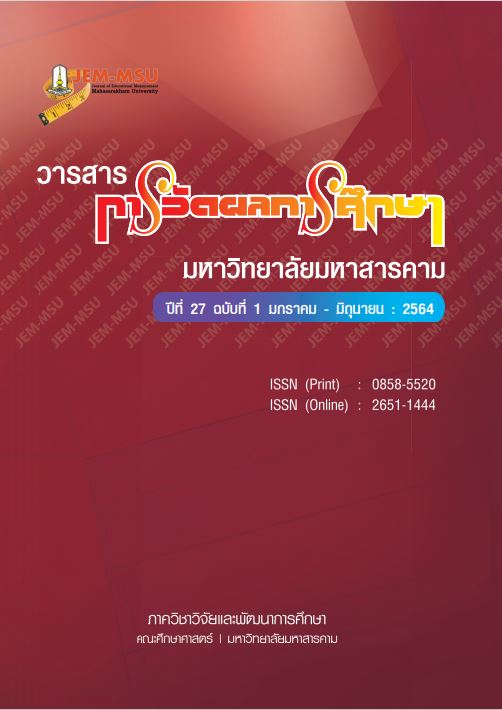The Structural Equation Model of Factors Influencing Behavioral Loyalty of Private University Students in Thailand
Main Article Content
Abstract
The objectives of this research were 1) to examine the model consistency of structural equation model of factors influencing behavioral loyalty of private university students in Thailand, 2) to analyze factors that had direct effect, indirect effect and total effect on behavioral loyalty of private university students in Thailand. The sample consisted of 400 students who attended private universities, obtained through purposive sampling. The instrument was a questionnaire. The data analysis employed descriptive statistics and the structural equation modeling: SEM. The results revealed that the service quality, image, and satisfaction had direct effect and indirect effect on loyalty of private university students in Thailand. All indexes which were GFI = 0.914, AGFI = 0.912, CFI = 0.988, RMSEA = 0.014, and SRMR = 0.0121, passed the criteria. This indicated that the structural equation model of factors influencing behavioral loyalty of private university students in Thailand was consistent with the empirical data.
Article Details
The content and information contained in the published article in the Journal of Educational Measurement Mahasarakham University represent the opinions and responsibilities of the authors directly. The editorial board of the journal is not necessarily in agreement with or responsible for any of the content.
The articles, data, content, images, etc. that have been published in the Journal of Educational Measurement Mahasarakham University are copyrighted by the journal. If any individual or organization wishes to reproduce or perform any actions involving the entirety or any part of the content, they must obtain written permission from the Journal of Educational Measurement Mahasarakham University.
References
กัลยา วานิชย์บัญชา. (2557). การวิเคราะห์สมการโครงสร้างด้วย AMOS. กรุงเทพฯ: โรงพิมพ์แห่งจุฬาลงกรณ์มหาวิทยาลัย.
สำนักงานคณะกรรมการการอุดมศึกษา. (2558). เกณฑ์มาตรฐานหลักสูตรระดับปริญญาตรี พ.ศ. 2558. [ออนไลน์]. ได้จาก http://www.mua.go.th/users/bhes/front_home/criterion58/criterion_b58.PDF. [สืบค้นวันที่ 7 มกราคม 2563].
Abd-El-Salam, E.M., Shawky, A.Y., & El-Nahas, T. (2013). The impact of corporate image and reputation on service quality, customer satisfaction and customer loyalty: Testing the Mediating role. Case analysis in an international service company. The Business and Management, 3(2), 177-196.
Chi, C.G.Q., & Qu, H. (2008). Examining the structural relationships of destination image, tourist satisfaction and destination loyalty: An integrated approach. Tourism Management, 29,624-636.
Cochran, W.G. (1953). Sampling Techniques. New York: John Wiley & Sons. Inc.
Cronin, J.R. (2000). Assessing the Effects of Quality, Value, and Customer Satisfaction on Consumer Behavioral Intention in Service Environments. Journal of Retailing, 76(2): 193-218.
Crosby, P. (1986). Quality is free. New York: McGrew-Hill.
Feigenbaum, A. (1987). Total Quality Management and business performance. Journal of Social and Behavioral Sciences, 129, 224-249.
Gures, N., Arslan, S., & Tun, S.Y. (2014). Customer expectation, satisfaction and loyalty relationship in Turkish education industry. International Journal of Marketing Studies, 6(1), 66-74.
Juran, J. (1989). Juran of leadership for quality. New York: Free Press.
Kotler, P. (2000). Marketing Management (10thed.). New Jersey: Prentice Hall.
Okeudo.G and Chikwendu.D.U. (2013). Effects of airline service quality on airline image and passenger loyalty: Findings from Arik Air Nigeria passengers. Journal of hospitality management and tourism, 4(2), 19-28.
Oliver, R.L. (2010). Satisfaction: A Behavioral Perspective on the consumer (2nd ed). Armonk, NY.
Omotayo & Joachim. (2008). Customer service in the retention of mobile phone users in Nigeria. African. Journal of Business Management. 2(2): 26-31.
Zeithaml, V. A., Parasuraman, A., & Berry, L. L. (1988). Delivering Quality Service: Balancing Customer Perceptions and Expectations, New York: The Free Press.


